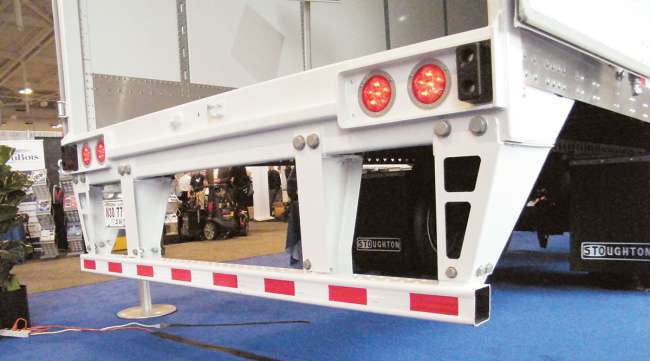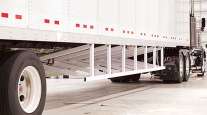Senior Reporter
Underride Committee May Ask for New Rear Guard Rule

[Stay on top of transportation news: Get TTNews in your inbox.]
A specially appointed committee reviewing truck underride guard safety is weighing whether to recommend that federal regulators toughen a 2022 rule on rear underride guards.
During a four-hour Feb. 8 meeting, the Advisory Committee on Underride Protection postponed a vote on the proposal until its next meeting on March 13. During the meeting, it also discussed research focused on underride guard design and resolved to begin discussion on the controversial topic of side underride guards on trailers.
The committee, a diverse group with strongly held opinions, has been charged by the National Highway Traffic Safety Administration with considering ways to save lives in underride crashes.
Matthew Brumbelow, a member of the committee and a senior research engineer with the Insurance Institute for Highway Safety, told the committee that there is evidence that rear impact crash fatalities are increasing despite the fact that many are not being reported by accident investigators.

Brumbelow
“Any time there are more than two vehicles involved in a crash, we can’t say conclusively that the passenger vehicle ran into a truck,” Brumbelow said. “So we often will exclude those. But obviously, there’s a problem with the way the truck and passenger vehicles are engaging with each other.”
He added, “NHTSA has estimated that 93% of the fleets are already compliant with the 2022 standard. But studies are showing that there is no benefit from rear guards if crash speeds are greater than 35 mph. We still would like to see an improvement in the regulation for semi-trailers and also in the standard for single-unit trucks.”
Following a presentation at the meeting on the decadeslong history of rear underride guard developments, committee Chairman Lee Jackson, a traffic crash reconstruction specialist, asked fellow committee member and trailer manufacturer executive Jeff Bennett why, after decades, regulators and trailer manufacturers haven’t solved the problem of rear underride.
“It’s a very difficult design task to have a guard that works in all scenarios,” said Bennett, the CEO of Utility Trailer Manufacturing Co. “It’s not a black-and-white situation. Since the days of the Jayne Mansfield [underride crash] tragedy, we have developed a lot of designs that have probably done a whole lot of good.” The 1950s actress died in 1967 when a vehicle she was traveling in crashed into the back of a tractor-trailer.

Deighton
Malcolm Deighton, an engineer with Hydro, discussed during a presentation before the committee his company’s aluminum rear underride guard, which he said has successfully crash-tested at 40 mph.
“The goal was to make this lighter than steel, and that’s very important in transportation — reducing weight,” Deighton said. “Our primary goal was to reduce weight, lower the fabrication cost and match the strength and provide a better product.”
As time went on, however, he noted that the company experimented with testing the strength of a guard that weighed as much as a steel unit. “Instead of trying to reduce the weight, let’s match the same weight and see how strong of a guard that we could make,” he said.
Deighton said he has found that aluminum material absorbs energy well and has in testing blocked a car’s cab from sliding underneath a trailer.

Horvath
Jackson suggested the committee include a formal recommendation for NHTSA to “expeditiously complete” a rulemaking that would require automatic emergency brake systems for all classes of commercial vehicles. Committee member Dan Horvath, senior vice president of regulatory affairs and safety policy for American Trucking Associations, agreed that AEB should be included more broadly in highway safety discussions and noted that regulators are already considering a rule mandate for the systems on passenger vehicles.
“I know there is another rulemaking moving through NHTSA,” he said. “Our view is that should apply to all vehicles on the road, not just trucks.”
But committee member Doug Smith, an owner-operator, said that AEB is “not ready for prime time.”
How does hydrogen fuel cell technology fit into freight transportation? Find out with Parker Meeks, the CEO of Hyzon, a company that designs and manufactures fuel cell technology for heavy-duty transport applications. Tune in above or by going to RoadSigns.ttnews.com.
“We’re seeing a lot of faults and near accidents caused by that,” Smith said. “And there’s no way to turn it off when you’re on slick roads. Every carrier in the world would want this if it works. But if you shove that down their throats, and it’s not ready, it’s just going to be a problem.”
RELATED: NHTSA Denies Petition to Remove Underride Guard Labeling Requirement
During the meeting, some committee members expressed disappointment that NHTSA denied their request to see data related to the agency’s decision in 2022 to mirror the Canadian rear guard standard. However, an NHTSA official said the agency chose not to provide the data since officials were involved in discussions that informed the formulation of the rulemaking.
Want more news? Listen to today's daily briefing below or go here for more info:





